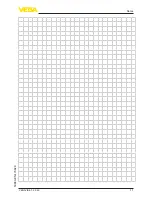
5
VEGAVIB 61, 62, 63
53863-EN-170828
3
Technical data
Electrical data
Ignition protection type intrinsic safety Ex i
Power supply and signal circuit: (termi
-
nals 1[+], 2[-] in "Ex-i" electronics com
-
partment; with double chamber housing
version in connection compartment)
In ignition protection type intrinsic safety Ex ia IIC/IIB
Only for connection to a certified, intrinsically safe circuit.
Maximum values:
•
U
i
= 30 V
•
I
i
= 131 mA
•
P
i
= 983 mW
C
i
negligible or in the version with fixed mounted con
-
nection cable,
Type series VB6*.CX***N3/5**, C
i'wire/wire
= 58 pF/m, C
i'wire/
screen
= 270 pF/m,
L
i
≤ 5 µH or in the version with fixed mounted connection
cable, type series VB6*.CX***N3/5**,
L
i
= 0.55 µH/m.
The intrinsically safe circuits are electrically separated from parts which can be grounded.
The metallic parts of VEGAVIB VB6*.C****Z**** are electrically connected with the earth terminals.
For applications requiring equipment of EPL Ga or EPL Ga/Gb, the intrinsically safe power supply
and signal circuit must correspond to protection class ia.
For applications requiring instruments of type EPL Ga resp. EPL Ga/Gb the VEGAVIB
VB6*.C****Z**** is preferably connected to appropriate equipment with galvanically isolated, intrinsi
-
cally safe circuits.
For applications requiring instruments of EPL Gb, the intrinsically safe power supply and signal
circuit can correspond to protection class ia or ib. For connection to a circuit with protection class ib,
the ignition protection type identification is Ex ib IIC T6.
4
Application conditions
The max. permissible ambient temperatures depending on the temperature class are specified in
the following table.
EPL Ga instrument
Temperature class
Permissible ambient temperature on the sensor
and electronics
T6
-20 … +39 °C
T5
-20 … +51 °C
T4, T3, T2, T1
-20 … +60 °C
Sect. 6.4.2/IEC 1127-1 is taken into account with respect to the indicated permissible ambient
temperatures on the sensor and electronics. The application conditions for operation in the absence
of explosive mixtures are stated in the operating instructions manual.






























